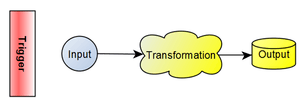At one extreme, a company is like a one-man band. You do everything. But at the other extreme it’s like a symphony orchestra where the conductor doesn’t make any of the music the audience has paid to hear. Just like in a large company, the CEO makes none of the products the customers pay for.
But how do you get from here to there?
The answer lies in systems. When companies are small, an owner will often equate the parts of the company with people. They know who does what. If they even have an org chart it lists people’s names or even their pictures in all the boxes. Thinking this way limits your ability to grow your company and your people’s ability to grow as well. Here’s a better way; think of your company as a collection of systems.
A system has four parts:
 Let’s apply that to the musicians. The drums are a system. The output is a rhythmic beat. The strings (or guitar for our one-man band) are another system. They output a melodious sound. The horns (or harmonica) output some bold, sassy notes. You get the idea. Now that we’ve separated the systems from the people, we can see that as long as all the right notes are played at the right time, the audience will recognize the tune.
Let’s apply that to the musicians. The drums are a system. The output is a rhythmic beat. The strings (or guitar for our one-man band) are another system. They output a melodious sound. The horns (or harmonica) output some bold, sassy notes. You get the idea. Now that we’ve separated the systems from the people, we can see that as long as all the right notes are played at the right time, the audience will recognize the tune.
With the one-man band, the same person operates all the systems. But in the orchestra, we have specialization. Not only does each person operate a single system, we have sub-systems. “Strings” becomes cello, viola, violins. This allows for a depth of expertise that can’t be accomplished with fewer players.
Key Point #1 Every Company At Every Size Uses All The Same Basic Systems.
But in smaller companies, one person is often responsible for several systems. Another thing that’s different about smaller companies, is that the systems are often done intuitively not procedurally. This is great when there’s only a few of you and you’re each really good. This is terrible as you start to scale because it’s hard to find more and more people with the experience and temperament to be intuitive. So what’s the solution?
- Define the systems explicitly, based on the output that’s needed.
- Make it clear who’s responsible for which systems.
- Document each system so you can train new people.
Now when you need to scale, you can bring someone in and train them on just one or two systems and off-load those systems from the person who was handling them before. That person can now move up – either in management, or in expertise. That’s what a meant when I said that systems enhance not just your company’s ability to grow but your people’s ability as well.
Key Point #2 There’s a Structure to How the Systems Interact.
In an orchestra, if I mess up on my violin, you can still play perfectly on your trumpet. The output of the systems are independent. But in a company, often the output of one system is the input to another. The systems are interdependent. So it’s useful to structure the systems that relate to each other together. At the highest level, we can group them into into 4 focus areas:

One level lower, we see the 12 main systems every company utilizes; 
And below that we can see all the systems in this fully expanded diagram:

Don’t get overwhelmed – if your company is alive, it’s already operating all these systems even if you don’t realize it. And that brings us to our third point in this post.
Key Point #3. The Structure (and the Systems) are the Same Across Industries
With the Exception of Systems Related to Making the Product You Sell
That means that the way to grow is to increase your capacity to sell and to serve your customers, by increasing the output of each system. Let’s consider why the orchestra needs a conductor and the one-man band doesn’t. The conductor keeps all the instruments (systems) playing in sync with each other. The one-man band does it all in his head. Likewise the CEO keeps all the systems in a company operating together. It doesn’t make sense (or profits) for the sales system to sell what the production systems can’t make, or for the hiring systems to hire people that the other systems don’t need.
Key Point #4 The CEO’s Job is To Keep All the Systems Operating Together.
Working ON Your Company Means Improving The Systems
Often we know we should work on our company, not in it. But we don’t know how to translate that into action. That’s why the Virtual CEO Boot Camp was developed. I’ve taken tools, models, exercises and action items that have helped my clients and packaged them into a number of modules. They are organized into the 4 Focus Areas I mentioned above so you can use them in whatever order you need.
